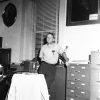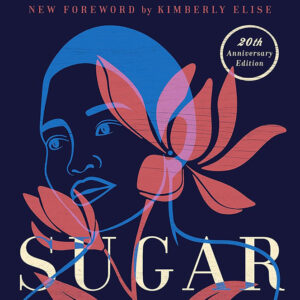calsfoundation@cals.org
Sugar Lacey Series
aka: Sugar [Book]
aka: This Bitter Earth [Book]
Sugar Lacey, a fictional character created by novelist Bernice L. McFadden, is the protagonist in Sugar and its sequel This Bitter Earth. The two novels center on a brutal murder of a young girl in 1940s Arkansas and the personal redemption of Sugar, an emotionally broken prostitute with a turbulent past. The series is a story of acceptance with a backdrop of the segregated South.
McFadden’s debut novel, Sugar (Dutton, 2000), introduced readers to the title character, Sugar Lacey. Most of the novel’s action takes place in 1955, but the story begins in 1940 with the brutal rape, murder, and mutilation of Jude, the young African-American daughter of Pearl Taylor in the small, mainly black fictional town of Bigelow. In the subsequent years, Jude’s mother has socially withdrawn, except for her steadfast reliance on religion and the local church. Taylor befriends Sugar Lacey, a prostitute who has recently moved into the house next door, which was left to Sugar upon the death of her mother. Sugar had been abandoned by her mother in the nearby town of Short Junction and was reared by Sara, May, and Ruby Lacey, sisters who were proprietors of the town’s whorehouse. She left Short Junction at age fifteen, the same day Jude Taylor was murdered. Flashbacks document the violence and degradation Sugar experienced throughout her life after leaving Short Junction, focusing on her time in St. Louis, Missouri, and Detroit, Michigan.
The women of Bigelow are horrified, yet fascinated, with the appearance of Sugar, a six-foot-tall African-American woman wearing a skin-tight dress, garish makeup, and a blond wig. They gossip about Sugar’s penchant for nudity and her overt sexuality, blaming her for their husbands’ infidelities. Pearl Taylor, however, strikes up a friendship with Sugar, initially with the intention of leading her into the fold of the Bigelow Baptist Church. Pearl is also drawn to Sugar by the latter’s resemblance to her deceased daughter, Jude. Despite Pearl’s initial ignorance of Sugar’s true profession, she remains loyal to her newfound friend when the truth is exposed.
Pearl’s friendship with Sugar improves the lives of both individuals. Sugar stops selling her body, quits smoking, and starts to attend church every Sunday. Her presence in the church makes many parishioners uncomfortable because of her former ways or, in the case of the men, because of her intimate knowledge of their sexual proclivities. Sugar also has a positive impact on Pearl, and the sadness and misery in both of their lives seem to disappear. The novel ends with Sugar returning to prostitution. This is done to help Pearl Taylor and her husband to raise some much needed money, but it ruins her friendship with the couple and a budding relationship with the Taylors’ son Seth. Sugar is almost killed by a client who himself has a tangled history with both the prostitute and the Taylors. The novel ends with Sugar leaving Bigelow after learning a Taylor family secret and discovering Jude’s killer.
This Bitter Earth (Dutton, 2002) continues the story of Sugar Lacey and picks up where Sugar left off, with Sugar leaving Bigelow. In late 1955, Sugar returns to the home of the three Lacey sisters in Short Junction. Upon arrival, she is near death due to the bitter cold, the strenuous walk from Bigelow, and the physical wounds she had received when a client nearly killed her. The three sisters nurse her back to health. The three sisters die, but before their deaths, Sugar learns more about her mother and the circumstances that brought her to the Lacey household.
In 1965, after ten years in Short Junction, Sugar sells the Lacey home, which she inherited from the sisters, and returns to St. Louis to visit her former madam and friend Mary Bedford, a character from the first novel. Upon her arrival in St. Louis, Sugar discovers Mary’s house in disrepair, Mary near death and living in filth, and Mary’s granddaughter Mercy addicted to heroin. Sugar cares for Mary until her death and unsuccessfully tries to wean Mercy off heroin. Ultimately, Sugar decides the only way to save Mercy is to return to Bigelow for a fresh start. Their bus ride is harrowing and filled with threats of violence from the white, racist citizenry in the small, whites-only Arkansas towns the bus travels through from St. Louis to Short Junction.
Upon arrival in Short Junction, Sugar is reunited with the Taylor family and is welcomed as a true member of their family since Sugar’s father is Pearl’s husband, Joe. Life in Bigelow begins to take on a bucolic nature, and Sugar finally feels like part of a family. Pearl has finally accepted Jude’s death, and Mercy starts to kick her heroin addiction, until the reappearance of Sugar’s would-be killer. This man exploits Mercy and her addiction to heroin in an effort to gain access to Sugar and fulfill his murderous plans. Sugar learns additional facts about her tragic history and how she is related to many of the townsfolk in Bigelow, including ones who scorned her in the first novel. Sugar also develops a budding singing career at a local bar. The novel ends in a brutal but revealing fashion, with the characters putting the past behind them.
Although Bigelow is presented in Sugar and This Bitter Earth as a fictional place in Arkansas, there is an actual town by that name in eastern Perry County. It is uncertain as to why or how McFadden chose the name Bigelow for the setting of the two books. The author is a native of Brooklyn, New York, and has no connection to Arkansas. However, it is mentioned in the author biography on the Sugar dustjacket noted that McFadden “grew up listening to family stories of Southern living. The roots of the South became her touchstone and the inspiration for Sugar.” The town of Short Junction, the main locale in This Bitter Earth, is indeed fictional, as there is no city in Arkansas by that name. The characterization of Bigelow is not accurate, as the town is described as a “small black town…with its flowering magnolia trees…endless rows of tract houses and white picket fences,” a description of pure artistic license.
Sugar was well-received and highly regarded by both the public and the literary community, becoming a bestseller. Authors Toni Morrison and Terry McMillan both praised McFadden for the originality of the novel, centered on a protagonist who has few redeeming characteristics and who initially does not want to be redeemed. This Bitter Earth did not enjoy the acclaim of its predecessor, and some considered it to lack the originality and daring nature of the first novel.
For additional information:
Burns, Ann, and Emily Joy Jones. Review of Sugar. Library Journal, November 1, 1999, p. 103.
Bush, Vanessa. Review of Sugar. Booklist, November 15, 1999, p. 605.
———. Review of This Bitter Earth. Booklist, January 1, 2002, p. 811.
Timothy G. Nutt
Historical Research Center
University of Arkansas for Medical Sciences
 Divergent Prosperity and the Arc of Reform, 1968–2022
Divergent Prosperity and the Arc of Reform, 1968–2022 Literature and Authors
Literature and Authors Sugar
Sugar 




Comments
No comments on this entry yet.